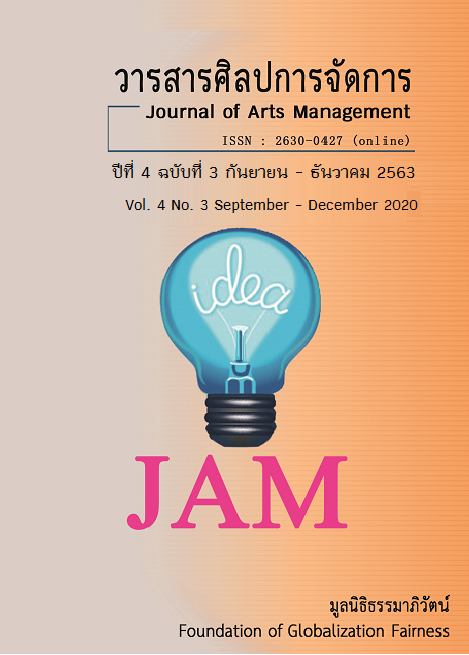The Attitudes of People Towards the Prevention and Treatment of Coronavirus COVID-19 According to the Four Noble Truths
Main Article Content
Abstract
The purposes of this research were 1) to study the attitudes of people towards the prevention and treatment of Coronavirus COVID-19 according to the Four Noble Truths, 2) to present the ways to prevent and treat Coronavirus COVID-19 according to the Four Noble Truths. The study was a mixed research method. The researcher used the research questionnaire to collect quantitative data from the samples of 151 respondents and collected qualitative data through interviewing 5 scholars. The statistics used in this research consisted of Frequency, Percentage, Mean and Standard Deviation. Descriptive analysis was used to analyze qualitative data.
The results of the research were as follows: The overall attitudes of people towards the prevention and treatment of Coronavirus COVID-19 according the Four Noble Truths were at high level. In particular, the attitudes of people about the ways to prevent Coronavirus COVID-19 were at the highest level, followed by attitudes about the effects of Coronavirus COVID-19, attitudes about the treatment of Coronavirus COVID-19, and attitudes about the causes of Coronavirus COVID-19. The ways to prevent and treat Coronavirus COVID-19 according to the Four Noble Truths are as follows: Being aware and understanding of Coronavirus COVID-19, avoidance and prevention of the causes of Coronavirus COVID-19, setting goals in the prevention and treatment of Coronavirus COVID-19, and following appropriate ways in the prevention and treatment of Coronavirus COVID-19 such as wearing mask, social distancing, avoidance of going to crowded places, and strengthening the mind, and so on.
Article Details
Views and opinions appearing in articles in the Journal of Arts of Management It is the responsibility of the author of the article. and does not constitute the view and responsibility of the editorial team I agree that the article is copyright of the Arts and Management Journal.
References
โกมาตร จึงเสถียรทรัพย์. (2563). มานุษยวิทยากับโรคระบาด: โคโรนาไวรัส โรคอุบัติใหม่กับงานวิจัยทางมานุษยวิทยา. กรุงเทพฯ: ศูนย์มานุษยวิทยาสิรินธร (องค์การมหาชน).
บุญญารัตน์ จันทวี, พระครูวิรุฬห์สุตคุณ และทองดี ศรีตระการ. (2563). ศึกษาการพัฒนาความรับผิดชอบของนักเรียนในศตวรรษที่ 21 โรงเรียนขยายโอกาสสำนักงานเขตพื้นที่การศึกษาประถมศึกษาพระนครศรีอยุธยา เขต 1. วารสารศิลปการจัดการ, 4(1), 23-33.
พนม พงษ์ไพบูลย์ และคณะ. (2528). สาโรช บัวศรี กับศึกษาศาสตร์ตามแนวพุทธศาสตร์. กรุงเทพฯ: โรงพิมพ์รุ่งเรืองสาส์นการพิมพ์.
พิมพ์พลอย เผือกพ่วง. (2561). การศึกษาการกระจายตัวของผู้ป่วยโรคระบาดในระบบข้อมูลสุขภาพด้วยการทำแผนที่ Dasymetric. วารสารวิจัยระบบสาธารณสุข, 12(3), 480-489.
พระธรรมปิฎก (ป.อ.ปยุตฺโต). (2538). พุทธธรรม (ฉบับปรับปรุงและขยายความ). กรุงเทพฯ: มหาจุฬาลงกรณราชวิทยาลัย.
พระพรหมคุณาภรณ์ (ป.อ.ปยุตฺโต). (2558). พจนานุกรมพุทธศาสตร์ ฉบับประมวลธรรม. กรุงเทพฯ: สำนักพิมพ์ผลิธัมม์.
พระเมธีธรรมาภรณ์ (ประยูร ธมฺมจิตฺโต). (2539). พุทธศาสนากับปรัชญา. กรุงเทพฯ: สำนักพิมพ์อมรินทร์พริ้นติ้ง กรุ๊พ จำกัด.
หนังสือพิมพ์กรุงเทพธุรกิจ (2563, 6 พฤษภาคม). WHO เตือนการระบาดของโควิด-19 ไม่ยุติลงในเร็ว ๆ นี้. สืบค้นเมื่อ 15 พฤษภาคม 2563. จาก https://www.bangkokbiznews.com
หนังสือพิมพ์ฐานเศรษฐกิจ (2563, 10 พฤษภาคม). ไทยก้องโลก ร่วมใจเอาชนะโควิด จากนี้วัดฝีมือฟื้นประเทศ. สืบค้นเมื่อ 15 พฤษภาคม 2563. จาก https://www.thansettakij.com
Alley, C., & Sommerfeld, J. (2014). Infectious diseases in time of social and ecological change. Medical Anthropology, 33(2), 85-91.
Barrett, R., Kuzawa, C.W., McDade, T., & Armelagos, G.I. (1998). Emerging infectious disease and the third epidemiological transition. Annual Review of Anthropology, 27, 247-271.
BBC News Thai. (2563, 2 พฤษภาคม). โควิด-19: การระบาดของไข้หวัดใหญ่สเปนเปลี่ยนโฉมหน้าโลกเราไปอย่างไร. สืบค้นเมื่อ 5 พฤษภาคม 2563. จาก https://www.bbc.com
BBC News Thai. (2563, 4 พฤษภาคม). ไวรัส โคโรนา: ที่มา อาการ การรักษาและการป้องกันโรคโควิด-19. สืบค้นเมื่อ 5 พฤษภาคม 2563. จาก https://www.bbc.com
Brown, H., & Nading, A. (2019). Introduction: Human animal health in Medical Anthropology. Medical Anthropology Quarterly, 33(1), 5-23.
Bureau of Epidemiology, Thailand. (2558). โรคระบาดในฤดูฝน (Epedimic in rainy). สืบค้นเมื่อ 9 มิถุนายน 2563. จาก http://www.boe.moph.go.th/files/news/20140602_72364531.pdf.
Money Buffalo. (2563, 16 เมษายน). 6 โรคระบาดครั้งใหญ่ของโลก. สืบค้นเมื่อ 14 พฤษภาคม 2563. จาก https://www.moneybuffalo.in.th
Nguyen, V. (2017). Viral speed: Infrastructure, Connectivity, Ontogeny; or, Notes on the Molecular Epidemiology of Epidemics. Cultural Anthropology, 32(1), 28-34.
Qiu, W., Rutherfeld, S., Mao, A., & Chu, C. (2017). The Pandemic and its Impact. Health, Culture and Society. 9-10, 1-11.


